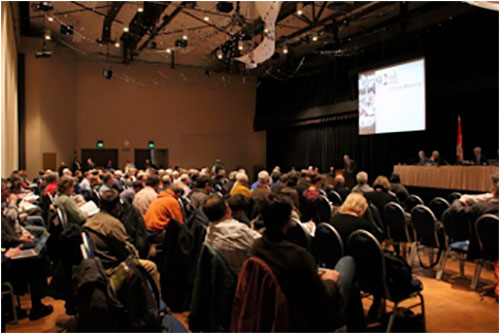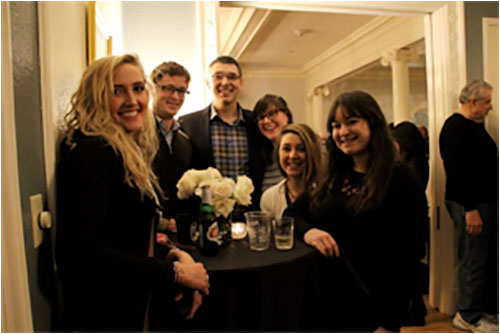
Fisheries students participate first hand as Halibut catch limits
for 2016 are set
March 8, 2016
Tuesday AM
(SitNews) Sitka, Alaska - Some Fisheries students have first hand experience in fishing boats ... but only rarely do students get a chance to listen, interact, and even influence the outcome of official fisheries management deliberations. This was the experience of a recent Fish Tech class at the University of Alaska Southeast Sitka.
Recently, Professor Joel Markis traveled to Juneau with a group of students enrolled in a Fisheries Policy course. Each year, the course syllabus calls for students to attend a different type of management meeting. This year, Markis and his students attended the International Pacific Halibut Commission (IPHC), alongside 360 other participants from both the US and Canada.

Attendees at the 92nd annual International Pacific Halibut Commission meeting held in Juneau
Photo by Tracee Geernaert IPHC
“It’s great when students can actually become a part of their course subject, beyond just learning about topics in the classroom,” commented Professor Markis. “I think of this as an example of us being true to our mission of coupling hands on learning with distance delivered coursework.” The Fisheries Technology program at the University of Alaska Southeast provides opportunities for its students to gain experience in the field, from measuring stream flow and gradient to spawning and collecting salmon eggs in hatcheries. Additionally, the program also provides opportunities to participate in another aspect of fisheries—management and policy.
Founded in 1923, the IPHC is unique in that it is an international organization that focuses on halibut research and management. The Commission receives support, staff, and funding from both Canada and the United States. The Commission researches halibut biology and population dynamics, and uses this information to make stock management recommendations. The Commission depends on the experience and suggestions of a number of different advisory bodies, including fishermen, processors, scientists, and government agencies from the US and Canada. Each year, the Commission holds a meeting to discuss the status of the halibut population in the North Pacific, propose ideas for future research, and set catch limits for the coming year. Hundreds of stake-holders attended from across North America including Markis and his students, who took the opportunity to better understand Halibut management and policy in this unique framework.

UAS-Sitka Fish Tech Students attend a reception at the Governor’s mansion in Juneau with Professor Joel Markis and IPHC commissioner Jeff Kauffman.
Photo by Tracee Geernaert IPHC
Students were impressed by the longevity and resiliency of the Commission, and how this influenced the way people interacted, how research was applied, and how the meeting functioned as a whole. “They’ve had a lot of time to figure it out. The [marine] environment has changed a lot since the Commission began, so they’ve been able to track these changes and adjust. They’ve been able to weather the storm,” Fish Tech student, Jessica Gill explains. Overall, it was a very professional exhibition of both the research the IPHC performs and how the fishery has been managed throughout the years.
Markis explains, “Students were able to listen, watch, and learn about the process, even participate in discussions at times.” Students had the chance to mingle with different stake-holders, from government officials to halibut harvesters and processors, each with a different opinion on the best way to manage the fishery. The students listened to a number of presentations, reports, and discussions, but they also had opportunities to get to know leaders in the fishing community on a more intimate level. Early on, the class was introduced to the audience. Markis explains, “Numerous people were interested in talking with the students about their impressions and understanding of this multiday process.”
“I was most impressed by how engaged the students were, and by how welcoming all of the commissioners, staff, managers, fishermen, and processors were by engaging the students in learning about this unique collaborative international process,” Markis says. “Everyone was very congenial. All the stake-holders, everyone seemed to get along,” Gill recalls. The Commission serves an example of how nations can successfully work together to achieve a common goal—in this case, maintaining the health of the Pacific Halibut fishery far into the future, while still supporting the livelihood of stake-holders today. As a result of the annual meeting, the Commission will recommend catch limits totaling 29.89 million pounds, a 2% increase from 2015. This includes an increase in the commercial and sport catch here in Southeast Alaska by 6%, totaling 4.95 million pounds.
For Professor Markis and his students, the highlight of this experience is seeing the behind the scenes work that goes into setting regulations for an enormously important industry in the region. Markis explains, “Many of these students will begin their career collecting data used to make these management decisions. At some point, they could be the ones making the management decisions themselves.”
The International Pacific Halibut Commission completed its 92nd Annual Meeting in Juneau on January 29, 2016.
Edited by Mary Kauffman, SitNews
Source of News:
University of Alaska Southeast – Sitka
www.uas.alaska.edu/sitka
Representations of fact and opinions in comments posted below are solely those of the individual posters and do not represent the opinions of Sitnews.
Publish A Letter in SitNews
Contact the Editor
SitNews ©2016
Stories In The News
Ketchikan, Alaska
|
Articles &
photographs that appear in SitNews may be protected by copyright
and may not be reprinted without written permission from and
payment of any required fees to the proper sources.
E-mail your news &
photos to editor@sitnews.us
Photographers choosing to submit photographs for publication to SitNews are in doing so granting their permission for publication and for archiving. SitNews does not sell photographs. All requests for purchasing a photograph will be emailed to the photographer.
|
|


